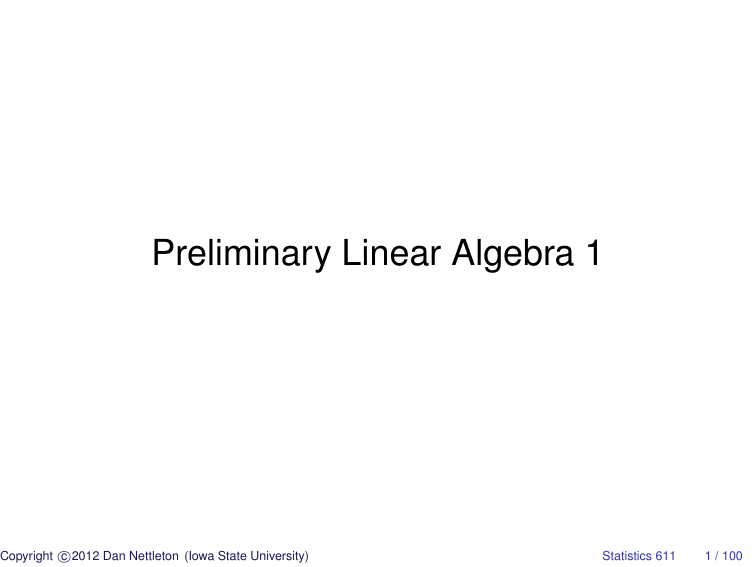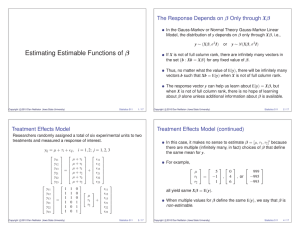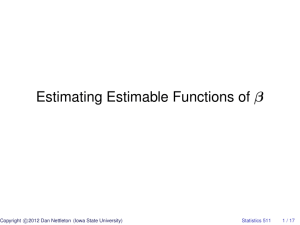Document 10639888
advertisement

Preliminary Linear Algebra 1
c
Copyright 2012
Dan Nettleton (Iowa State University)
Statistics 611
1 / 100
Notation
∀
for all
∃
there exists
3
such that
∴
therefore
∵
because
end of proof (QED)
c
Copyright 2012
Dan Nettleton (Iowa State University)
Statistics 611
2 / 100
Notation
A =⇒ B
A implies B
A ⇐⇒ B
A if and only if (iff) B
a∈B
a is an element of the set B
A⊂B
A is a proper subset of B
A⊆B
A is a subset of B
Rn
Euclidean n-space
c
Copyright 2012
Dan Nettleton (Iowa State University)
Statistics 611
3 / 100
Matrix Notation
a11
a12
· · · a1n
a21 a22 · · · a2n
A = [aij ] = .
is a matrix with m rows and n
..
..
.
m×n
.
.
m×n
.
.
.
.
am1 am2 · · · amn
columns.
The entry in the ith row and jth column of A is aij .
c
Copyright 2012
Dan Nettleton (Iowa State University)
Statistics 611
4 / 100
Square Matrices and Vectors
Matrixm×n
A is said to be square if m = n.
A matrix with one column is called a vector.
A matrix with one row is called a row vector.
c
Copyright 2012
Dan Nettleton (Iowa State University)
Statistics 611
5 / 100
Notation
In these STAT611 notes, bold uppercase letters are typically used to
denote matrices, and bold lowercase letters are typically used to
denote vectors.
c
Copyright 2012
Dan Nettleton (Iowa State University)
Statistics 611
6 / 100
Examples
0 or 0n is a vector of zeros.
1 or 1n is a vector of ones.
I or In or In×n is the identity matrix. For example,
1 0 0
I3 =
0 1 0 = diag(1, 1, 1).
0 0 1
c
Copyright 2012
Dan Nettleton (Iowa State University)
Statistics 611
7 / 100
Special Types of Square Matrices
A square matrixn×n
A is upper triangular if aij = 0, ∀ i > j.
A square matrixn×n
A is lower triangular if aij = 0, ∀ i < j.
A square matrixn×n
A is diagonal if aij = 0, ∀ i 6= j.
Write one example for each of these types of matrices.
c
Copyright 2012
Dan Nettleton (Iowa State University)
Statistics 611
8 / 100
Matrix Transpose
Ifm×n
A = [aij ], the transpose of A, denoted A0 , is the matrixn×m
B = [bij ],
where bij = aji , ∀ i = 1, . . . , m;
j = 1, . . . , n.
That is, B = A0 is the matrix whose columns are the rows of A and
whose rows are the columns of A.
c
Copyright 2012
Dan Nettleton (Iowa State University)
Statistics 611
10 / 100
A Symmetric Matrix
A square matrixn×n
A is symmetric if A = A0 .
c
Copyright 2012
Dan Nettleton (Iowa State University)
Statistics 611
11 / 100
Examples
Find the transpose of
"
4 −2
3
#
.
7
Provide an example of a symmetric matrix.
c
Copyright 2012
Dan Nettleton (Iowa State University)
Statistics 611
12 / 100
Matrix Multiplication
Suppose
a01
A = [aij ] = ... = [a(1) , . . . , a(n) ]
m×n
a0m
and
0
b1
..
B = [bij ] = . = [b(1) , . . . , b(k) ].
n×k
b0n
Then
A B = C = [cij =
m×n
n×k
n
X
m×k
ail blj ] = [cij = a0i b(j) ]
l=1
a01 B
n
X
= [Ab(1) , . . . , Ab(k) ] = ... =
a(l) b0l .
l=1
a0m B
c
Copyright 2012
Dan Nettleton (Iowa State University)
Statistics 611
14 / 100
Matrix Multiplication
Suppose
A=
"
#
1 2
3 4
and
B=
Work out AB using AB =
c
Copyright 2012
Dan Nettleton (Iowa State University)
"
#
5 6
.
7 8
(l) 0
l=1 a bl .
Pn
Statistics 611
15 / 100
Transpose of a Matrix Product
(AB)0 = B0 A0
The transpose of a product is the product of the transposes in
reverse order.
c
Copyright 2012
Dan Nettleton (Iowa State University)
Statistics 611
17 / 100
Scalar Multiplication of a Matrix
If c ∈ R, then c times the matrix A is the matrix whose i, jth element is c
times the i, jth element of A; i.e.,
ca11
ca12
· · · ca1n
ca21 ca22 · · · ca2n
cm×n
A = c[aij ] = [caij ] = .
.
.
.
.
..
..
..
..
m×n
m×n
cam1 cam2 · · · camn
c
Copyright 2012
Dan Nettleton (Iowa State University)
Statistics 611
18 / 100
Linear Combination
If x1 , . . . , xn ∈ Rm and c1 , . . . , cn ∈ R, then
n
X
ci xi = c1 x1 + · · · + cn xn
i=1
is a linear combination (LC) of x1 , . . . , xn .
The coefficients of the LC are c1 , . . . , cn .
c
Copyright 2012
Dan Nettleton (Iowa State University)
Statistics 611
19 / 100
Linear Independence and Linear Dependence
A set of vectors x1 , . . . , xn is linearly independent (LI) if
n
X
ci xi = 0 ⇐⇒ c1 = · · · = cn = 0.
i=1
A set of vectors x1 , . . . , xn is linearly dependent (LD) if
∃ c1 , . . . , cn not all 0 3
n
X
ci xi = 0.
i=1
c
Copyright 2012
Dan Nettleton (Iowa State University)
Statistics 611
20 / 100
Prove or disprove: any set of vectors that contains the vector 0 is
LD.
Prove or disprove: The following set of vectors is LI.
7
9
−5 , 4 , −6 .
3
1
7
c
Copyright 2012
Dan Nettleton (Iowa State University)
1
Statistics 611
21 / 100
Fact V1:
The nonzero vectors x1 , . . . , xn are LD ⇐⇒ xj is a LC of x1 , . . . , xj−1 for
some j ∈ {2, . . . , n}.
c
Copyright 2012
Dan Nettleton (Iowa State University)
Statistics 611
24 / 100
Orthogonality
The two vectors x, y are orthogonal to each other if their
inner product is zero, i.e.,
0
0
xy=yx=
n
X
xi yi = 0.
i=1
The length of a vector, also known as its Euclidean norm, is
kxk :=
√
v
u n
uX
0
xx=t
x2 .
i
i=1
c
Copyright 2012
Dan Nettleton (Iowa State University)
Statistics 611
26 / 100
The vectors x1 , . . . , xn are mutually orthogonal if
x0i xj = 0,
∀ i 6= j.
The vectors x1 , . . . , xn are mutually orthonormal if
x0i xj = 0
∀ i 6= j, and kxi k = 1
c
Copyright 2012
Dan Nettleton (Iowa State University)
∀ i = 1, . . . , n.
Statistics 611
27 / 100
Write down a set of mutually orthogonal but not mutually
orthonormal vectors.
Write down a set of mutually orthonormal vectors.
c
Copyright 2012
Dan Nettleton (Iowa State University)
Statistics 611
28 / 100
Orthogonal Matrix
A square matrix with mutually orthonormal columns is called an
orthogonal matrix.
c
Copyright 2012
Dan Nettleton (Iowa State University)
Statistics 611
30 / 100
Show that if Q is orthogonal, then Q0 Q = I.
Show that if Q is orthogonal and x is any vector of appropriate
dimension, then kQxk = kxk.
c
Copyright 2012
Dan Nettleton (Iowa State University)
Statistics 611
31 / 100
An orthogonal matrix Q is sometimes called a rotation matrix because
if a vector x is premultiplied by Q, the result (Qx) is the vector x rotated
n×1
to a new position in
n×n
Rn .
c
Copyright 2012
Dan Nettleton (Iowa State University)
Statistics 611
34 / 100
Vector Space
A vector space S is a set of vectors that is closed under addition (i.e., if
x1 ∈ S, x2 ∈ S, then x1 + x2 ∈ S) and closed under scalar multiplication
(i.e., if c ∈ R, x ∈ S, then cx ∈ S).
In other words,
c1 x1 + c2 x2 ∈ S
c
Copyright 2012
Dan Nettleton (Iowa State University)
∀ c1 , c2 ∈ R; x1 , x2 ∈ S.
Statistics 611
35 / 100
Is {x ∈ Rn : kxk = 1} a vector space?
Is {x ∈ Rn : 10 x = 0} a vector space?
Is {n×m
Ax : x ∈ Rm } a vector space?
c
Copyright 2012
Dan Nettleton (Iowa State University)
Statistics 611
36 / 100
Generators of a Vector Space
A vector space S is said to be generated by a set of vectors x1 , . . . , xn if
x ∈ S =⇒ x =
n
X
ci xi for some c1 , . . . , cn ∈ R.
i=1
c
Copyright 2012
Dan Nettleton (Iowa State University)
Statistics 611
40 / 100
Span of a Set of Vectors
The span of vectors x1 , . . . , xn is the set of all LC of x1 , . . . , xn , i.e.,
span{x1 , . . . , xn } =
( n
X
)
ci xi : c1 , . . . , cn ∈ R .
i=1
span{x1 , . . . , xn } is the vector space generated by x1 , . . . , xn .
c
Copyright 2012
Dan Nettleton (Iowa State University)
Statistics 611
41 / 100
Find a set of vectors that generates the space
{x ∈ R3 : 10 x = 0};
i.e., find a set of vectors whose span is
S = {x ∈ R3 : 10 x = 0}.
c
Copyright 2012
Dan Nettleton (Iowa State University)
Statistics 611
42 / 100
Basis of a Vector Space
If a vector space S is generated by LI vectors x1 , . . . , xn , then x1 , . . . , xn
form a basis for S.
c
Copyright 2012
Dan Nettleton (Iowa State University)
Statistics 611
44 / 100
Fact V2:
Suppose a1 , . . . , an form a basis for a vector space S. If b1 , . . . , bk are
LI vectors in S, then k ≤ n.
c
Copyright 2012
Dan Nettleton (Iowa State University)
Statistics 611
45 / 100
Proof of Fact V2:
Because a1 , . . . , an form a basis for S and b1 ∈ S, b1 =
Pn
i=1 ci ai
for some c1 , . . . , cn ∈ R. Thus, a1 , . . . , an , b1 are LD by Fact V1.
Again, using V1, we have aj a LC of b1 , a1 , . . . , aj−1 for some
j ∈ {1, 2, . . . , n}.
c
Copyright 2012
Dan Nettleton (Iowa State University)
Statistics 611
46 / 100
Thus, b1 , a1 , . . . , aj−1 , aj+1 , . . . , an generate S. It follows that
b1 , a1 , . . . , aj−1 , aj+1 , . . . , an , b2 is a LD set of vectors by V1.
Again by V1, one of the vectors b1 , b2 , a1 , . . . , aj−1 , aj+1 , . . . , an is a
LC of the preceding vectors. It is not b2 ∵ b1 , . . . , bk are LI.
c
Copyright 2012
Dan Nettleton (Iowa State University)
Statistics 611
47 / 100
Thus b1 , b2 and n − 2 of a1 , . . . , an generate S.
If k > n, we can continue adding b vectors and deleting a vectors
to get b1 , . . . , bn generates S. However, then V1 would imply
b1 , . . . , bn+1 are LD. This contradicts LI of b1 , . . . , bk ∴ k ≤ n.
c
Copyright 2012
Dan Nettleton (Iowa State University)
Statistics 611
48 / 100
Fact V3:
If {a1 , . . . , an } and {b1 , . . . , bk } each provide a basis for a vector space
S, then n = k.
Proof: By V2, we have k ≤ n and n ≤ k. ∴ k = n.
c
Copyright 2012
Dan Nettleton (Iowa State University)
Statistics 611
49 / 100
Dimension of a Vector Space
A basis for a vector space is not unique, but the number of vectors in
the basis, known as dimension of the vector space, is unique.
c
Copyright 2012
Dan Nettleton (Iowa State University)
Statistics 611
50 / 100
Find dim(S), the dimension of vector space S, for
S = {x ∈ R3 : 10 x = 0}.
c
Copyright 2012
Dan Nettleton (Iowa State University)
Statistics 611
51 / 100
Consider the set {0}. Is this a vector space? If so, what is its
n×1
dimension?
c
Copyright 2012
Dan Nettleton (Iowa State University)
Statistics 611
53 / 100
Fact V4:
Suppose a1 , . . . , an are LI vectors in a vector space S with dimension n.
Then a1 , . . . , an form a basis for S.
c
Copyright 2012
Dan Nettleton (Iowa State University)
Statistics 611
55 / 100
Fact V5:
If a1 , . . . , ak are LI vectors in an n-dimensional vector space S, then
there exists a basis for S that contains a1 , . . . , ak .
c
Copyright 2012
Dan Nettleton (Iowa State University)
Statistics 611
57 / 100
Fact V6:
If a1 , . . . , ak are LI and orthonormal vectors in Rn , then there exist
ak+1 , . . . , an such that a1 , . . . , an are LI and orthornormal.
Proof: HW problem.
c
Copyright 2012
Dan Nettleton (Iowa State University)
Statistics 611
59 / 100
Rank of a Matrix
It can be shown that
the (maximum) number of LI rows of a matrixm×n
A is the same as the
(maximum) number of LI columns ofm×n
A.
This number of LI rows or columns is known as the rank ofm×n
A and
is denoted rank(m×n
A) or r(m×n
A).
c
Copyright 2012
Dan Nettleton (Iowa State University)
Statistics 611
60 / 100
If r(m×n
A) = m,m×n
A is said to have full row rank.
If r(m×n
A) = n,m×n
A is said to have full column rank.
c
Copyright 2012
Dan Nettleton (Iowa State University)
Statistics 611
61 / 100
Inverse of a Matrix
If r(n×n
A) = n, there exists a matrixn×n
B such thatn×n
A n×n
B =n×n
I.
Such a matrix B is called the inverse of A and is denoted A−1 .
c
Copyright 2012
Dan Nettleton (Iowa State University)
Statistics 611
62 / 100
Prove that r(n×n
A) = n ⇐⇒ ∃n×n
B 3n×n
A n×n
B =n×n
I.
Prove thatn×n
A n×n
B =n×n
I =⇒n×n
B n×n
A =n×n
I
Thus AA−1 = A−1 A = I.
c
Copyright 2012
Dan Nettleton (Iowa State University)
Statistics 611
63 / 100
Singular / Nonsingular Matrix
If r(n×n
A) = n,n×n
A is said to be nonsingular.
If r(n×n
A) < n,n×n
A is said to be singular.
c
Copyright 2012
Dan Nettleton (Iowa State University)
Statistics 611
68 / 100
Inverse of a Nonsingular 2 × 2 Matrix
"
a b
#−1
=
c d
"
a b
c d
"
1
ad−bc
d
−b
−c
a
#
if ad − bc 6= 0.
#
is singular if ad − bc = 0.
c
Copyright 2012
Dan Nettleton (Iowa State University)
Statistics 611
69 / 100
Column Space of a Matrix
A, denoted by C(A), is the vector space
The column space of a matrixm×n
generated by the columns ofm×n
A; i.e.,
C(A) = {Ax : x ∈ Rn }.
c
Copyright 2012
Dan Nettleton (Iowa State University)
Statistics 611
70 / 100
dim(C(A)) = r(m×n
A) because the largest possible subset of LI columns of
A is a basis for C(A).
m×n
c
Copyright 2012
Dan Nettleton (Iowa State University)
Statistics 611
71 / 100
Let
1 0 3
A=
2 1 4 .
4 2 8
Find r(A).
Give a basis for C(A).
Characterize C(A).
c
Copyright 2012
Dan Nettleton (Iowa State University)
Statistics 611
72 / 100
Result A.1:
rank(AB) ≤ min{rank(A), rank(B)}
c
Copyright 2012
Dan Nettleton (Iowa State University)
Statistics 611
76 / 100
Proof of Result A.1:
Let b1 , . . . , bn denote the columns of B so that B = [b1 , . . . , bn ].
Then AB = [Ab1 , . . . , Abn ]. This implies that the columns of AB are
in C(A).
c
Copyright 2012
Dan Nettleton (Iowa State University)
Statistics 611
77 / 100
dim(C(A)) is rank(A).
There does not exist a set of LI vectors in C(A) with more than
rank(A) vectors by Fact V2.
It follows that rank(AB) ≤ rank(A).
c
Copyright 2012
Dan Nettleton (Iowa State University)
Statistics 611
78 / 100
It remains to show that
rank(AB) ≤ rank(B).
Note that rank(AB) is the same as rank((AB)0 ) = rank(B0 A0 ).
Our previous argument shows that
rank(B0 A0 ) ≤ rank(B0 ) = rank(B).
c
Copyright 2012
Dan Nettleton (Iowa State University)
Statistics 611
79 / 100
Provide an example where
rank(AB) < min{rank(A), rank(B)}.
c
Copyright 2012
Dan Nettleton (Iowa State University)
Statistics 611
80 / 100
Result A.2:
(a) If A = BC, then C(A) ⊆ C(B),
(b) If C(A) ⊆ C(B), then there exist C such that A = BC.
c
Copyright 2012
Dan Nettleton (Iowa State University)
Statistics 611
82 / 100
Null Space of a Matrix
The null space of a matrix A, denoted N (A) is defined as
N (A) = {y : Ay = 0}.
Note that N (A) is the set of vectors orthogonal to every row of A.
c
Copyright 2012
Dan Nettleton (Iowa State University)
Statistics 611
85 / 100
A vector in N (A) can also be seen as a vector of coefficients
corresponding to a LC of the columns of A that is 0.
c
Copyright 2012
Dan Nettleton (Iowa State University)
Statistics 611
86 / 100
Note that if A has dimension m × n, then the vectors in C(A) have
dimension m and the vectors in N (A) have dimension n.
c
Copyright 2012
Dan Nettleton (Iowa State University)
Statistics 611
87 / 100
Is the null space of a matrixm×n
A a vector space?
c
Copyright 2012
Dan Nettleton (Iowa State University)
Statistics 611
88 / 100
Find the null space of
1
2
2
4
A=
.
−1 −2
3
6
c
Copyright 2012
Dan Nettleton (Iowa State University)
Statistics 611
90 / 100
Result A.3:
rank(m×n
A) = n ⇐⇒ N (A) = {0}.
c
Copyright 2012
Dan Nettleton (Iowa State University)
Statistics 611
92 / 100
Theorem A.1:
If the matrix A is m × n with rank r, then
dim(N (A)) = n − r,
or more elegantly,
dim(N (m×n
A)) + dim(C(m×n
A)) = n.
c
Copyright 2012
Dan Nettleton (Iowa State University)
Statistics 611
94 / 100
Proof of Theorem A.1:
Let k = dim(N (A)). Results A.3 covers the case where k = 0.
Suppose now that k > 0.
Let u1 , . . . , uk form a basis for N (A). Then
Aui = 0 ∀ i = 1, . . . , k.
m×n
By Fact V5, there exist uk+1 , . . . , un such that u1 , . . . , un form a
basis for Rn .
c
Copyright 2012
Dan Nettleton (Iowa State University)
Statistics 611
95 / 100
We will now argue that the n − k vectors Auk+1 , . . . , Aun form a
basis for C(A).
If so, then
dim(N (A)) + dim(C(A)) = k + n − k = n,
i.e.,
dim(N (A)) = n − dim(C(A)) = n − r.
c
Copyright 2012
Dan Nettleton (Iowa State University)
Statistics 611
96 / 100
First note that Aui ∈ C(A) ∀ i = k + 1, . . . , n.
Now note that
ck+1 Auk+1 + · · · + cn Aun = 0
=⇒ A(ck+1 uk+1 + · · · + cn un ) = 0
=⇒ ck+1 uk+1 + · · · + cn un ∈ N (A)
=⇒ ∃ c1 , . . . , ck ∈ R 3 c1 u1 + · · · + ck uk =
n
X
cj u j
j=k+1
=⇒ c1 u1 + · · · + ck uk − ck+1 uk+1 − · · · − cn un = 0
=⇒ c1 = · · · = cn = 0 by LI of u1 , . . . , un .
c
Copyright 2012
Dan Nettleton (Iowa State University)
Statistics 611
97 / 100
Therefore, Auk+1 , . . . , Aun are LI.
Now let U = [u1 , . . . , un ].
Because u1 , . . . , un are LI and a basis for Rn , ∃ U−1 3 UU−1 = I.
Let x ∈ Rn be arbitrary and define z = U−1 x.
c
Copyright 2012
Dan Nettleton (Iowa State University)
Statistics 611
98 / 100
Then
Ax = AUU−1 x = AUz
= [Au1 , . . . , Auk , Auk+1 , . . . , Aun ]z
= [0, . . . , 0, Auk+1 , . . . , Aun ]z
= zk+1 Auk+1 + · · · + zn Aun .
Therefore, any vector in C(A) can be written as a LC of
Auk+1 , . . . , Aun .
c
Copyright 2012
Dan Nettleton (Iowa State University)
Statistics 611
99 / 100
It follows that
Auk+1 , . . . , Aun is a basis for C(A).
∴ n − k = r and k + r = n.
c
Copyright 2012
Dan Nettleton (Iowa State University)
Statistics 611
100 / 100





